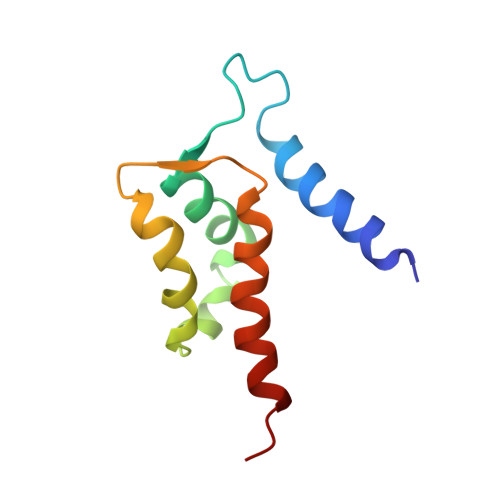Structural and motional changes induced in apo-S100A1 protein by the disulfide formation between its Cys 85 residue and beta-mercaptoethanol
Zhukov, I., Ejchart, A., Bierzynski, A.(2008) Biochemistry 47: 640-650
- PubMed: 18088104
- DOI: https://doi.org/10.1021/bi701762v
- Primary Citation of Related Structures:
2JPT - PubMed Abstract:
Recently, we have shown (Goch, G., Vdovenko, S., Kozłowska, H., and Bierzyński, A. (2005) FEBS J. 272, 2557-2565) that the chemical modification of Cys 85 residue of S100A1 protein by disulfide bond formation with small thiols such as glutathione, cysteine, or beta-mercaptoethanol (betaME) leads to a dramatic increase of the protein affinity for calcium. Therefore, the biological function of S100A1 as a calcium signal transmitter is probably regulated by the redox potential within the cell. Systematic, structural studies of various mixed disulfides of S100A1 in the apo and holo states are necessary to elucidate the mechanism of this phenomenon. Using NMR methods we have determined the structure of apo-S100A1-betaME and, on the basis of 15N nuclear magnetic relaxation data, we have characterized the structural dynamics of both: modified and unmodified molecules of apo-S100A1. The following effects of betaME modification have been observed: (1) Helices IV and IV' of two protein subunits are elongated by five residues (85-89). (2) Conformation of the calcium binding N-terminal loops is dramatically changed, and structural flexibility of the N-loops as well as C-loops markedly increases. (3) The angle between helices I and IV increases by approximately 20 degrees and between helices IV and IV' decreases by approximately 35 degrees . All these observations lead to the conclusion that betaME modification of apo-S100A1 makes its structure more similar to that of holo-S100A1, so that it becomes much better adjusted for calcium coordination.
Organizational Affiliation:
Institute of Biochemistry and Biophysics, Polish Academy of Sciences, Pawińskiego 5A, 02-106 Warsaw, Poland.















